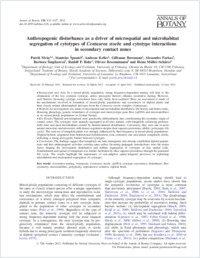Anthropogenic disturbance as a driver of microspatial and microhabitat segregation of cytotypes of Centaurea stoebe and cytotype interactions in secondary contact zones
- Mráz, Patrik Department of Biology, Unit of Ecology and Evolution, University of Fribourg, Switzerland
- Španiel, Stanislav Institute of Botany, Slovak Academy of Sciences, Bratislava, Slovakia
- Keller, Andreas Department of Biology, Unit of Ecology and Evolution, University of Fribourg, Switzerland
- Bowmann, Gillianne Department of Biology, Unit of Ecology and Evolution, University of Fribourg, Switzerland
- Farkas, Alexandre Department of Biology, Unit of Ecology and Evolution, University of Fribourg, Switzerland
- Šingliarová, Barbora Institute of Botany, Slovak Academy of Sciences, Bratislava, Slovakia
- Rohr, Rudolf P. Department of Biology, Unit of Ecology and Evolution, University of Fribourg, Switzerland
- Broennimann, Olivier Department of Ecology and Evolution, University of Lausanne, Switzerland
- Müller-Schärer, Heinz Department of Biology, Unit of Ecology and Evolution, University of Fribourg, Switzerland
-
13.04.2012
Published in:
- Annals of Botany. - 2012, vol. 110, no. 3, p. 615-627
Assortative mating
Asteraceae
Centaurea stoebe
cpDNA
cytotype coexistence
disturbance
flow cytometry
microsatellites
polyploidy
reproductive isolation
triploid block
English
Background and Aims: In a mixed-ploidy population, strong frequency-dependent mating will lead to the elimination of the less common cytotype, unless prezygotic barriers enhance assortative mating. However, such barriers favouring cytotype coexistence have only rarely been explored. Here, an assessment is made of the mechanisms involved in formation of mixed-ploidy populations and coexistence of diploid plants and their closely related allotetraploid derivates from the Centaurea stoebe complex (Asteraceae).Methods: An investigation was made of microspatial and microhabitat distribution, life-history and fitness traits, flowering phenology, genetic relatedness of cytotypes and intercytotype gene flow (cpDNA and microsatellites) in six mixed-ploidy populations in Central Europe.Key Results: Diploids and tetraploids were genetically differentiated, thus corroborating the secondary origin of contact zones. The cytotypes were spatially segregated at all sites studied, with tetraploids colonizing preferentially drier and open microhabitats created by human-induced disturbances. Conversely, they were rare in more natural microsites and microsites with denser vegetation despite their superior persistence ability (polycarpic life cycle). The seed set of tetraploid plants was strongly influenced by their frequency in mixed-ploidy populations. Triploid hybrids originated from bidirectional hybridizations were extremely rare and almost completely sterile, indicating a strong postzygotic barrier between cytotypes.Conclusions: The findings suggest that tetraploids are later immigrants into already established diploid populations and that anthropogenic activities creating open niches favouring propagule introductions were the major factor shaping the non-random distribution and habitat segregation of cytotypes at fine spatial scale. Establishment and spread of tetraploids was further facilitated by their superior persistence through the perennial life cycle. The results highlight the importance of non-adaptive spatio-temporal processes in explaining microhabitat and microspatial segregation of cytotypes.
- Faculty
- Faculté des sciences et de médecine
- Department
- Département de Biologie
- Language
-
- English
- Classification
- Biological sciences
- License
-
License undefined
- Identifiers
-
- RERO DOC 29534
- DOI 10.1093/aob/mcs120
- Persistent URL
- https://folia.unifr.ch/unifr/documents/302540
Other files
Statistics
Document views: 162
File downloads:
- Supplementary material: 185
- Fichier principal: 133

